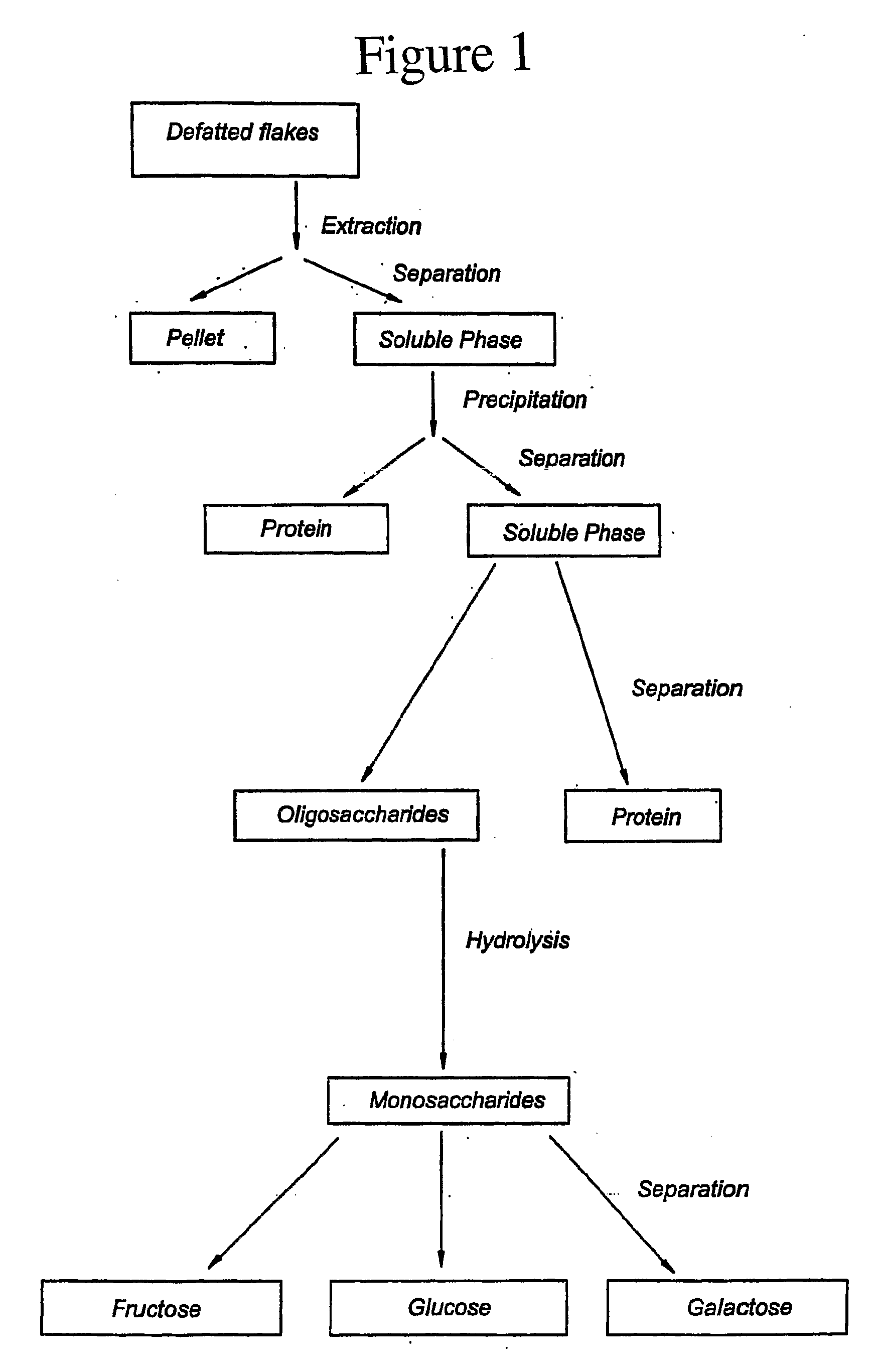Monosaccharide production system
a production system and monosaccharide technology, applied in the field of monosaccharide production system, can solve the problems of limited milk supply, prone to contamination, lactose may not be suitable as an ingredient in foodstuffs for people suffering from milk intolerance or in foodstuffs prepared as kosher food
- Summary
- Abstract
- Description
- Claims
- Application Information
AI Technical Summary
Problems solved by technology
Method used
Image
Examples
example 1
[0037]The process may be carried out at a commercially attractive scale, i.e. at least on a scale equal to pilot scale. On a pilot plant scale, 150 liters of water having a temperature of about 200 C may be added to 30 kg defatted soybean flakes and stirred to form a uniform mixture. After 20 minutes, insoluble components in the mixture may be separated from the soluble fraction by decanting. Hydrochloric acid may be added to the soluble fraction to conduct acid precipitation at pH 4.5, followed by centrifugation at 7800×g to separate the insolubles from the solubles. The soluble fraction may be further treated using ultrafiltration. The ultrafiltration membrane may have a theoretical molecular weight cut-off of 5.000 Daltons. The retentate may be separated from the permeate, which may contain soluble saccharides. The permeate is expected to contain about 50% saccharides on dry weight basis.
[0038]0.1% Alpha-gal 600L (Novo-Nordisk) based on dry matter may be added. (Alpha-gal 600L is...
example 2
[0039]Defatted soybean flakes are treated with 10 times their weight of water to which NaOH may be added to adjust the pH to 8.5. After an hour of mixing, the solution is separated from insolubles by centrifugation. The separated solution is treated with an ultrafiltration membrane with molecular weight cut-off of 30,000 Daltons. Proteins and other high molecular weight solutes are retained on the membranes, while the oligosaccharides permeate through the membrane. The permeate also contains sucrose, fructose and glucose. The permeate is treated with a yeast fermenting those sugars to ethanol. Most of the ethanol is distilled out of the yeast-treated permeate. The aqueous solution after the distillation of ethanol is treated with Alpha-gal as in Example 1 to hydrolyze the oligosaccharides contained in it. The D-galactose content of the preparation obtained is expected to be about 15-25 percent.
example 3
[0040]CaCl2 and Ca(OH)2 are added to D-galactose preparation formed according to Example 2 and the temperature is adjusted to 25 C. Galactose is converted to tagatose, which forms a complex with Ca(OH)2.
PUM
| Property | Measurement | Unit |
|---|---|---|
| Fraction | aaaaa | aaaaa |
| Fraction | aaaaa | aaaaa |
| Fraction | aaaaa | aaaaa |
Abstract
Description
Claims
Application Information
 Login to View More
Login to View More - R&D
- Intellectual Property
- Life Sciences
- Materials
- Tech Scout
- Unparalleled Data Quality
- Higher Quality Content
- 60% Fewer Hallucinations
Browse by: Latest US Patents, China's latest patents, Technical Efficacy Thesaurus, Application Domain, Technology Topic, Popular Technical Reports.
© 2025 PatSnap. All rights reserved.Legal|Privacy policy|Modern Slavery Act Transparency Statement|Sitemap|About US| Contact US: help@patsnap.com

